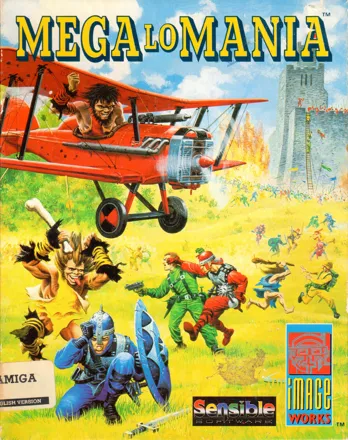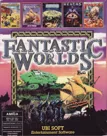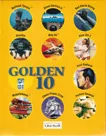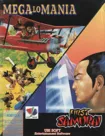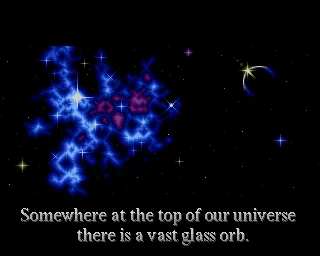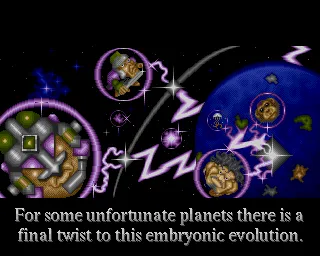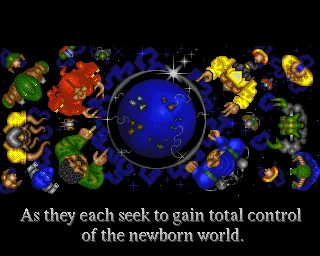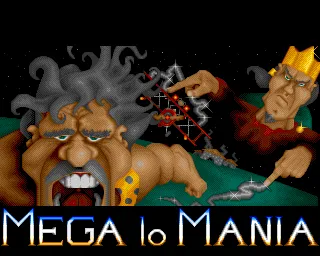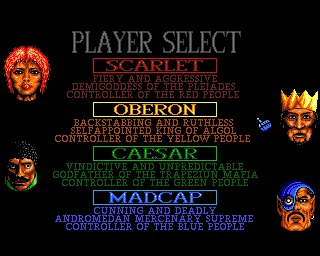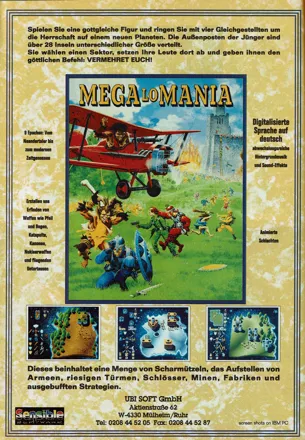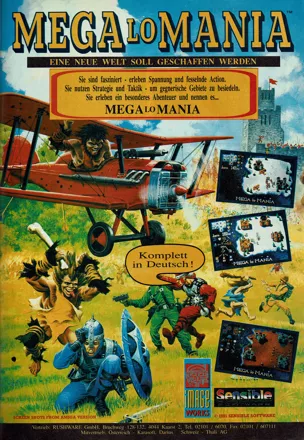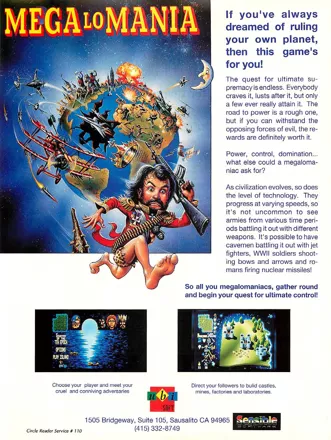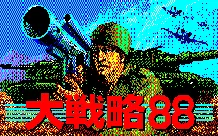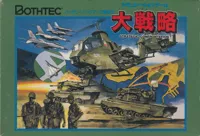Mega lo Mania
Description official description
First you choose one out of four different characters to represent you, Scarlet (red army), Oberon (yellow army), Caesar (green army), or Madcap (blue army). The game is split into 10 levels - the first 9 are groups of 3 territories which can be completed in any order, while the final 'Mother of All Battles' has its own surprises.
Land is mostly of sand, grass or ice. You start with 100 men and you can use whatever quantity you find necessary on each island. The rest men left will go to another level with another new 100. In the second half of the game you can freeze men to save them for the Mother of All Battles.
Once you select your island and place for your HQ, you must do some research for better weapons and defences. On the roof of your buildings you can put protectors like archers, gunmen, boiling oil men, and later on even laser turrets. If you send a team of unarmed men into an unoccupied square, they will build an additional base there, with larger armies completing this more quickly.
Later on higher levels, you'll also build mines and factories, as you'll need to dig a certain material for higher level weapons, depending on whether the area you're on is rich with a certain material or not. With each next level, you'll start from a higher technology level and be able to progress to one higher level up than at the previous level.
If there is more than just one enemy, you can make an alliance until you crush the other one - three of you can form an alliance against fourth enemy. For what its worth, a certain numeric level of defence is always stronger from the same level of attacker, and men that are not armed (conscripts) can only kill enemy soldiers, not destroy or attack enemy fort.
The main thing as always in strategy games is to be the sole survivor and lead your men to victory, experimenting on vicious technologies, equipping your men, making perfect soldiers out of them, produce shields, weapons, planes... to dominate the world and crush your opponents.
You can do the battling only in a certain quadrant, but don't be long as your men will automatically start building the fort, and it will be at the bottom of age level and you'll need to invent everything for that one again.
Spellings
- Megalomania - Normalised spelling
- メガロマニア -時空大戦略- - Japanese SNES spelling
Groups +
Screenshots
Promos
Credits (Amiga version)
11 People
| Designed and Directed by | |
| Programmed by | |
| Graphics | |
| Music | |
| Sound | |
| Title Graphics | |
| Title Music | |
| Featuring |
|
| Additional Design | |
| Additional Programming | |
| Additional Graphics |
Reviews
Critics
Average score: 83% (based on 31 ratings)
Players
Average score: 3.9 out of 5 (based on 70 ratings with 3 reviews)
The Good
Mega lo Mania is a gem of a game. It was created by Sensible Software, who were well known at the time for their superior quality games. Above all, their games were always designed with the objective that they would be fun to play.
This game is of an early breed of real-time strategy games then popularly referred to as God Games. And it's an excellent one at that. There is never a problem with too much micromanagement, as becomes a problem so often with the genre. The game mechanics are elegant and simple, never bogging you down, never overwhelming.
Mega lo Mania is all about allocating resources efficiently. You constantly find yourself having to balance expansion vs. advancement. A bigger army vs. a more advanced army. Add to that the fact that you need to allocate people to mining resources to build your vast army, since more advanced equipment costs more resources.
The graphics are simple, colorful, and cartoony. The interface is also very simple and intuitive. After you've played one map you've already mastered the interface. You don't have to click individual soldiers, and there are no annoying AI problems with your minions. It's easy enough for a child to pick up, but challenging enough for anyone. And it doesn't take an expert mouser to become good at it (unlike C&C and the like, where life or death depends on the speed of your mouse).
The game avoids becoming repetitive by allowing you to advance a little further technologically on each map. On the first map you only get slingshots and spears, but as the game progresses you get more and more high-tech toys to play with. There's also a speed setting so you can fast forward over the boring bits and slow down when things get really hectic.
In fact, Mega lo Mania is quite the opposite of boring. It's one of the most intensely addictive games I have ever played.
The Bad
There's really not much to dislike here. The graphics and interface sometimes feel a little lacking. The interface is all icons and it's not always immediately obvious how to get from one part to the other. Luckily, the interface is very simple, so there's not much to get lost in.
Also, it can be extremely frustrating when you're almost through to completing a level and the opposition just seems to gang up on you. Make no mistake, the latter levels of this game are very difficult, but you only ever have to start over at the beginning of the current island. It never gets so frustrating that you don't want to give it just one more go.
The only other complaint I have is that Mega lo Mania ruined for me the genre of real-time strategy forever. I could never get into Command & Conquer, Red Alert, Warcraft and the like, because I would always think "Mega lo Mania was so much more fun than this".
The Bottom Line
Sensible Software's Mega lo Mania followed in the wake of a slew of God Games in the late 80's and early 90's. It was Sensible's first and only attempt at such a game, and in my opinion it's the best game they ever made.
It's really very difficult to describe this game, although the concept is beutifully simple. At heart, Mega lo Mania is a real-time strategy game. But you have to remember this was before there was Dune 2, before there was Command & Conquer, Warcraft, etc. So it doesn't really play like other real-time strategy games. This is a good thing.
You start out by selecting one of 4 pre-created characters who will become the leader of your people. The game is centered around a series of islands, each of which you must conquer by becoming the only tribe on the island.
The island maps are divided into squares, each one with its own set of resources. When you start an island, each player selects one square to build his home tower. The people you sent will be contained within the tower and you can allocate jobs to each of them. Your people can mine resources, defend the tower, and most importantly, research new technologies. You start with no technology whatsoever, your tower is a straw hut and your people must defend it with their bare hands. When you allocate people to research, you can invent sticks and stones as weapons, and better materials to build your tower. When you finish researching 3 technologies, you advance a tech level. Your tower becomes a clay structure and your people fight with spears and slingshots, then pikes and bows, and eventually stealth bombers and nuclear weapons.
People in the tower who are not assigned a task will breed to create more people. When you have enough people, you can create an army. Arm them with the weapons of your choice, for which you will pay with resources like "moonlite" and "solarium", and deploy your army. You can move the army into an adjacent square to start a new tower, or to destroy your enemies' towers.
With each new tower you build, the resources available will be different, so you must "reinvent the wheel", literally, each time you start a new tower. Two towers build armies faster than one, but new technology is researched faster with more people at your most advanced tower, so the game becomes an issue of allocating your resources wisely and expanding at just the right time. Eventually, if all goes well, you will have a vast army of cave men, knights, catapults and ballistic missiles with which to bring the opposition to its knees and conquer the whole island.
DOS · by Runar Bjarnason (3) · 2003
A typical slice of Sensible brilliance
The Good
There's a lot of humour, ranging from the fantastic speech to the level names (which succeed alphabetically) and some of the graphics.
Unlike too many strategy games, there is a significant change in the gameplay as you progress, with mines and factories to churn out more advanced hardware, as well as the nuclear threat progressively leaving less usable territories.
The system of each section having different resources is excellent, making careful use of different squares to produce different types of weaponry.
The Bad
The final 'Mother of All Battles' is embarassingly easy, even if you haven't saved many men from previous levels. Then again, it will have taken you a lot of play just to get that far.
The Bottom Line
A sideways look at the God-sim genre, adding some much-needed humour and invention to the genre. Your task is to win 28 levels against up to 3 computer opponents. Each level is divided into a number of squares, each of which must be individually conquered. Empty ones can be claimed simply by sending a group of unarmed men in, but inhabited ones must be won in battle.
Different types of attacking and defensive weaponry can be built, using the various resources in each section. As a level progresses, your men become more advanced, allowing improved technology to be made. Each later level starts from later tech-levels as well
Amiga · by Martin Smith (81712) · 2004
One of the best games ever made
The Good
Everything about this game is perfect. In fact it's so perfect it's scary. The learning curve is perfect, the game appears deceptively simple, even on first play. The music, the interface, the hilarious voices, all of this would be nothing without addictive and satisfying gameplay. Thankfully it's here in a abundance.
The Bad
The graphics are a little simplistic, the sounds took a while to load even on a 2MB machine. That's about it.
The Bottom Line
It's funny how games get forgotten over time, and this is certainly one I'd never had imagined would be forgotten, but it has. Once upon a time (before Sensible Golf) Sensible Software were the masters of all they surveyed, and Mega lo Mania stood proud for it knew it was destined for great things.
Amiga · by Johnny "ThunderPeel2001" Walker (476) · 2004
Trivia
1001 Video Games
Mega lo Mania appears in the book 1001 Video Games You Must Play Before You Die by General Editor Tony Mott.
Cancelled sequels
Plans were made for a 'data disk' with new missions for April/May 1992, and a sequel, Mega lo Mania 2 at end of 1992. Subsequently, neither releases never appeared.
Competition
Amiga Format in January 1992 ran a competition whereby two lucky winners could have their face and voices digitized as villains in forthcoming "Mega-lo-Mania" data disks. Other prizes were a copy of the game, a T-shirt or mug. In humorous Amiga Format-style entry forms were addressed to 'Dressing Room Mirrorsoft Compo'.
Cut content
The original recordings for the game had Madcap saying, "No way, shithead!". This was trimmed for the game to just, "No way!", although the original files were still stored on the disks.
Information also contributed by Garcia
Analytics
Identifiers +
Contribute
Are you familiar with this game? Help document and preserve this entry in video game history! If your contribution is approved, you will earn points and be credited as a contributor.
Contributors to this Entry
Game added by MAT.
Amiga added by EboMike. Genesis added by PCGamer77. Linux, Macintosh, Windows added by Plok. PC-98 added by Infernos. Antstream added by firefang9212. Atari ST added by Ratqueen. SNES added by Mobygamesisreanimated. FM Towns, Sharp X68000 added by Terok Nor.
Additional contributors: PCGamer77, Johnny "ThunderPeel2001" Walker, Freeman, Plok, Rik Hideto, FatherJack.
Game added October 1, 2000. Last modified February 13, 2025.


